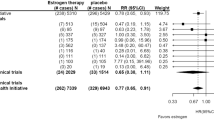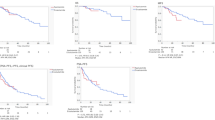Abstract
Anastrozole, letrozole and vorozole are new aromatase inhibitors with a nonsteroidal structure (NSS), and have been demonstrated to be highly effective and better tolerated than standard endocrine therapy with megestrol (megestrol acetate) and aminoglutethimide (AG).
These agents are very potent and selective: all of them are capable of suppressing estrone (El) and estradiol (E2) to the limit of sensitivity methods, and plasma estrone sulfate (EIS) levels are also suppressed. However, the fact that this potency has not led to any greater clinical efficacy, and that there is no relationship between estrogen suppression and clinical response, suggests that aromatase inhibitors may have additional mechanisms of action.
A number of international, multicentre clinical trials have compared anastrozole, letrozole and vorozole with megestrol 160 mg/day or AG 500 mg/day plus hydrocortisone in patients with advanced breast cancer. Letrozole proved to be significantly more effective than megestrol but anastrozole had a greater effect on survival than either agent. However, letrozole therapy led to longer survival than that observed in patients treated with AG. The activity of vorozole was similar to that of megestrol and AG.
These results have raised a number of questions. The first is how should the clinical results be evaluated, given that ‘disease stabilisation lasting ≥6 months’ has been considered a response? The second is how should these drugs be used, and whether there is a rationale for using them in combination or sequentially in the treatment of patients with advanced breast cancer? Finally, is the possible effect of formestane and vorozole on intratumoral aromatase an alternative or concomitant mechanism of action?
Anastrozole, letrozole and vorozole will be compared with tamoxifen in postmenopausal patients with breast cancer in adjuvant and primary settings. However, we feel that concomitant biological and clinical studies should also be carried out in order to clarify the properties of these drugs and avoid possible risks for patients over time.
Similar content being viewed by others
References
Brodie AMH, Njar VCO. Aromatase inhibitors and breast cancer. Semin Oncol 1996; 23(4): 10–20
Buzdar AU, Plourde PV, Hortobagyi GN. Aromatase inhibitors in metastatic breast cancer. Semin Oncol 1996; 23(4): 28–32
Coombes RC, Huges SWM, Dowsett M. 4-Hydroxyandrostenedione: a new treatment for postmenopausal patients with breast cancer. Eur J Cancer 1992; 28A: 1941–5
Goss PE, Powles TJ, Dowsett M, et al. Treatment of advanced postmenopausal breast cancer with an aromatase inhibitor, 4-hydroxyandrostenedione: phase II report. Cancer Res 1986; 46: 4823–6
Höffken K, Jonat W, Possinger K, et al. Aromatase inhibition with 4-hydroxyandrostenedione in the treatment of postmenopausal patients with advanced breast cancer: a phase II study. J Clin Oncol 1990, 8: 875–80
Stein RC, Dowsett M, Hedley A, et al. Treatment of advanced breast cancer in postmenopausal women with 4-hydroxyandrostenedione. Cancer Chemother Pharmacol 1990; 26: 75–8
Brodie AMH, Schwarzel WC, Shaikh AA, et al. The effect of an aromatase inhibitor, 4-hydroxy-4-androstene-3,17-dione, on estrogen dependent processes in reproduction and breast cancer. Endocrinology 1977; 100: 1684–95
Brodie AMH, Garret WM, Tsai-Morris CH, et al. Aromatase inhibition: a new perspective in the treatment of breast cancer. In: Brunner HR, Salvetti A, Server PS, editors. Aminoglutethmide as an aromatase inhibitor in the treatment of cancer. Berne: Hans Huber Publishers, 1984: 11–23
Bhatnagar AS, Häusler A, Schieweck K, et al. Estrogen depletion in advanced breast cancer: why, how and where are we going? In: Rubens RD, editor. Advanced breast cancer: reassessing hormonal therapy. London: Parthenon Publishing, 1996: 21–30
Bhatnagar AS, Bowman RM, Schieweck K, et al. Letrozole: from test tube to patients In: Mourisden HT. editor. New options for the therapy of advanced breast cancer. London: Parthenon Publishing, 1996: 9–14
Yates RA, Dowsett M, Fisher GV, et al. Arimidex (ZD1033): a selective, potent inhibitor of aromatase in postmenopausal female volunteers. Br J Cancer 1996; 73: 543–8
Plourde PV, Dyroff M, Dowsett M, et al. Arimidex: a new oral, once-a-day aromatase inhibitor. J Steroid Biochem Mol Biol 1995; 53: 175–9
Dowsett M, Goss PE, Powles TJ, et al. Use of the aromatase inhibitor 4-hydroxyandrostenedione in post-menopausal breast cancer: optimisation of therapeutic dose and route. Cancer Res 1987; 47: 1957–61
Jonat W, Howell A, Blomqvist C, et al. Arandomised trial comparing two doses of the new selective aromatase inhibitor anastrozole (arimidex) with megestrol acetate in postmenopausal patients with advanced breast cancer. Eur J Cancer 1996; 32: 404–12
Buzdar A, Jonat W, Howell A, et al. Anastrozole, a potent and selective aromatase inhibitor, versus megestrol acetate in postmenopausal women with advanced breast cancer: results of an overview analysis of two phase III trials: Arimidex Study Group. J Clin Oncol 1996; 14: 2000–11
Buzdar A, Jonat W, Howell A, et al. Anastrozole versus megestrol acetate in the treatment of postmenopausal women with advanced breast carcinoma. Cancer 1998; 83: 1142–52
Bhatnagar AS, Hausier A, Schieweck K, et al. Highly selective inhibition of estrogen biosynthesis by CGS 20267, a new nonsteroidal aromatase inhibitor. Steroid Biochem Mol Biol 1990; 37: 1021–7
Lipton A, Deniers LM, Harvey HA, et al. Letrozole (CGS 20267): a phase I study of a new potent oral aromatase inhibitor of breast cancer. Cancer 1995; 75: 2132–8
Deniers LM, Lipton A, Harvey HA, et al. The efficacy of CGS 20267 in suppressing estrogen biosynthesis in patients with advanced breast cancer. J Steroid Biochem Mol Biol 1993; 44: 687–91
Bajetta E, Zilembo N, Dowsett M, et al. Double-blind, randomised, multicentre endocrine trial comparing two letrozole doses, in postmenopausal breast cancer patients. Eur J Cancer 1999; 35: 208–13
Bisagni G, Cocconi G, Scaglione F, et al. Letrozole, a new oral non-steroidal aromatase inhibitor in treating postmenopausal patients with advanced breast cancer: a pilot study. Ann Oncol 1996; 7: 99–102
Dombernowsky P, Smith I, Falkson G, et al. Letrozole, a new oral aromatase inhibitor for advanced breast cancer: double-blind randomized trial showing a dose effect and improved efficacy and tolerability compared with megestrol acetate. J Clin Oncol 1998; 16: 453–61
Gershanovich M, Chaudri HA, Campos D, et al. Letrozole, a new oral aromatase inhibitor: randomised trial comparing 2.5 mg daily, 0.5 mg daily and aminoglutethimide in postmenopausal women with breast cancer. Ann Oncol 1998; 9: 639–45
Wiseman LR, Spencer CM. Vorozole. Drugs Aging 1997; 3: 245–50
De Jong PC, van de Ven J, Nortier HW, et al. Inhibition of breast cancer tissue aromatase activity and estrogen concentrations by the third-generation aromatase inhibitor vorozole. Cancer Res 1997; 57: 2109–11
Johnston SRD, Smith IE, Doody D, et al. Clinical and endocrine effects of the oral aromatase inhibitor vorozole in post menopausal patients with advanced breast cancer. Cancer Res 1994; 54: 5875–81
Goss PE, Winer EP, Tannock IF, et al. Randomized phase III trial comparing the new potent and selective third-generation aromatase inhibitor vorozole with megestrol acetate in postmenopausal advanced breast cancer patients. J Clin Oncol 1999; 17: 52–63
Bergh J, Bonneterre J, Illiger HJ, et al. Vorozole (Rivizor) versus aminoglutethimide (AG) in the treatment of postmenopausal breast cancer relapsing after tamoxifen [abstract no. 543]. Proceedings of the 33rd Annual Meeting of the American Society of Clinical Oncology (ASCO); 1997 May 17–20; Denver (CO). J Clin Oncol 1997; 16: 155a
Noberasco C, Bajetta E, Zilembo N, et al. Activity of formestane in de novo tamoxifen-resistant patients with metastatic breast cancer. Oncology 1995; 52: 454–7
Hayward JL, Carbone PP, Heuson JC, et al. Assessment of response to therapy in advanced breast cancer. Eur J Cancer 1997; 13: 89–94
Castiglione-Gertsch M. New aromatase inhibitors: more selectivity, less toxicity, unfortunately, the same activity. Eur J Cancer 1996; 32A(5): 393–5
Bernhard J, Thurliman B, Hsu Schmitz F, et al. Defining clinical benefit in postmenopausal patients with breast cancer under second-line endocrine treatment: does quality of life matter? J Clin Oncol 1999; 17: 1672–9
Bajetta E, Zilembo N, Buzzoni R, et al. Endocrinological and clinical evaluation of two doses of formestane in advanced breast cancer. Br J Cancer 1994; 70: 145–50
Bajetta E, Zilembo N, Barni S, et al. A multicenter, randomized, pharmacokinetic, endocrine and clinical study to evaluate formestane in breast cancer patients at first relapse: endocrine and clinical results: the Italian Trials in Medical Oncology (ITMO) group. Ann Oncol 1997; 8: 649–54
Hamilton A, Piccart M. The third-generation non-steroidal aromatase inhibitors: a review of their clinical benefit in the second-line hormonal treatment of advanced breast cancer. Ann Oncol 1999; 10: 377–84
Brodie A, Long B, Liu Y, et al. Aromatase inhibitors and their antitumor effects in model systems [abstract]. International Symposium on Aromatase and its Inhibitors: New Biology and Clinical Perspectives; 1998 Sep 3–6; Prague
MacNeill FA, Jacobs S, Lonning PE, et al. Combined treatment with 4-hydroxyandrostenedione and aminoglutethimide on aromatase inhibition and oestrogen suppression. Br J Cancer 1994; 69: 1171–5
Geisler J, Johannessen DC, Anker G, et al. Treatment with formestane alone and in combination with aminoglutethimide in heavily pretreated breast cancer patients: clinical and endocrine effects. Eur J Cancer 1996; 32(5): 789–92
Harper-Wynne CL, Coombes RC. Benefit from using formestane followed by anastrozole in advanced breast cancer [abstract]. International Symposium on Aromatase and its Inhibitors: New Biology and Clinical Perspectives; 1998 Sep 3–6; Prague
Murray R, Pitt P. Aromatase inhibition with 4-OH androstenedione after prior aromatase inhibition with aminoglutethimide in women with advanced breast cancer. Breast Cancer Res Treat 1995; 35: 249–53
Thurlimann B, Paridaens R, Serin D, et al. Third-line hormonal treatment with exemestane in postmenopausal patients with advanced breast cancer progression on aminoglutethimide: a phase II multicenter multinational study: the Exemestane Study Group. Eur J Cancer 1997; 33: 1767–73
Howell A, Defriend D, Anderson E. Clues to the mechanism of endocrine resistance from clinical studies in advanced breast cancer. Endocr Related Cancer 1995; 2: 131–9
Miller WR, Forrest APM. Oestradiol synthesis from C19 steroids by human breast cancers. Br J Cancer 1976; 33: 116–8
Dowsett M, Lee K, Macaulay VM, et al. The control and biological importance of intratumoral aromatase in breastcancer. J Steroid Biochem Mol Biol 1996; 56: 145–50
Miller WR, O’Neill J. The importance of local synthesis of estrogen within the breast. Steroids 1987; 50: 537–48
Yue W, Wang J, Savinov A, et al. Effect of aromatase inhibitors on growth of mammary tumors in a nude mouse model. Cancer Res 1995; 55: 3073–7
Yue W, Zhou D, Chen S, et al. A new nude mouse model for postmenopausal breast cancer using MCF-7 cell transfected with human aromatase gene. Cancer Res 1994; 54: 5092–5
Lu Q, Nakamura J, Savinov A, et al. Expression of aromatase protein and messenger ribonucleic acid in tumor epithelial cells and evidence of functional significance of locally produced estrogen in human breast cancers. Endocrinology 1996; 137: 3061–8
Reed MJ, Aherne GW, Ghilchik MW. Concentrations of estrone and 4-hydroxyandrostenedione in malignant and normal breast tissue. Int J Cancer 1991; 49: 562–5
Lee K, Macaulay M, Nicholls JE, et al. An in vivo model of intratumoral aromatase using aromatase-transfected MCF7 human breast cancer cells. Int J Cancer 1995; 62: 297–302
Pérez Carrion R, Alberola Candel V, Calabresi F, et al. Comparison of the selective aromatase inhibitor formestane with tamoxifen as first-line therapy in postmenopausal women with advanced breast cancer. Ann Oncol 1994; 5Suppl. 7: S19–24
Author information
Authors and Affiliations
Corresponding author
Rights and permissions
About this article
Cite this article
Bajetta, E., Zilembo, N. & Bichisao, E. Aromatase Inhibitors in the Treatment of Postmenopausal Breast Cancer. Drugs Aging 15, 271–283 (1999). https://doi.org/10.2165/00002512-199915040-00003
Published:
Issue Date:
DOI: https://doi.org/10.2165/00002512-199915040-00003




